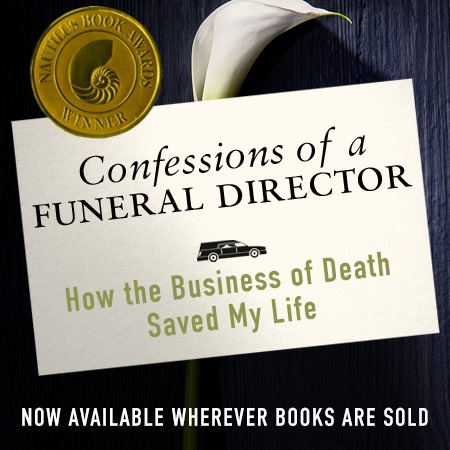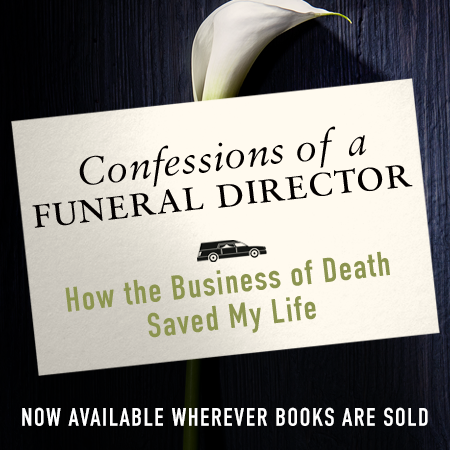Active Remembering
About that really mean (and viral) obituary …
Obituaries rarely go viral, but when they do it’s usually for their creativity, originality, or inspirational message. Sometimes, though, they go viral for their vitriol. Below is the latest viral vitriol obituary that’s making it’s rounds all over the internet:
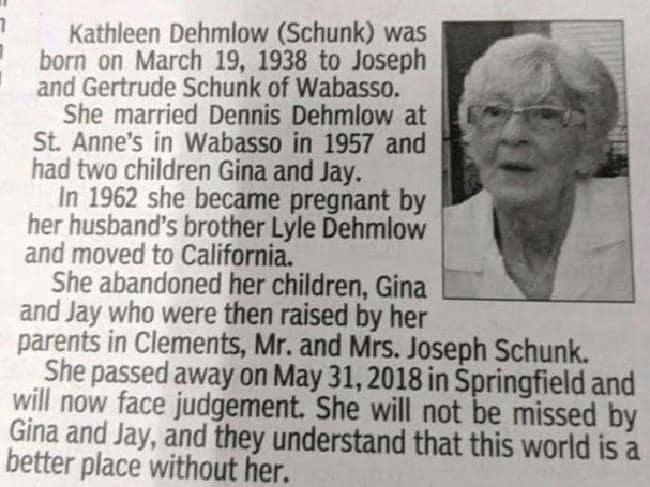
Picture: Rewood Falls Gazette
As horrible as this obituary is, it pales in comparison to some others I’ve read. For example:
Marianne Theresa Johnson-Reddick born Jan 4, 1935 and died alone on Aug. 30, 2013. She is survived by her 6 of 8 children whom she spent her lifetime torturing in every way possible. While she neglected and abused her small children, she refused to allow anyone else to care or show compassion towards them. When they became adults she stalked and tortured anyone they dared to love. Everyone she met, adult or child was tortured by her cruelty and exposure to violence, criminal activity, vulgarity, and hatred of the gentle or kind human spirit.
On behalf of her children whom she so abrasively exposed to her evil and violent life, we celebrate her passing from this earth and hope she lives in the after-life reliving each gesture of violence, cruelty, and shame that she delivered on her children. Her surviving children will now live the rest of their lives with the peace of knowing their nightmare finally has some form of closure.
Such obituaries garner a number of reactions. Some people find some vicarious satisfaction when seeing bad people publically shamed. Some are simply saddened that one life could cause so much pain and hurt that it’d prompt such an obituary. Others are angered that the family would publically shame the dead … who have no ability to defend themselves Still, others think it’s cathartic, a healthy way for victims to cope with the pain and violence
Shaming of the dead is nothing new. Historically, using an obituary to shame the deceased is charitable, at least compared to some of the other ways we’ve done it.
We only have to go back to Muammar Gaddafi’s death. Remember him? The Libyan despot? Remember how photos of his bloated and mutilated corpse flashed across TV screens, news websites, and newspapers? THAT is death shaming.
In many cultures, if you want to show contempt to the deceased, you bury them facedown.
Criminal’s bodies have often been put on display like pieces of meat in a butcher shop.
And the dead bodies of the defeated during war times are often disrespected in unmarked graves, or hung on buildings, bridges, and stakes.
In my book, I talk about something I call “active remembering”. I talk about how we usually remember the dead passively, but active remembering is doing it intentionally. It’s intentionally bringing the dead into the spaces of the living.
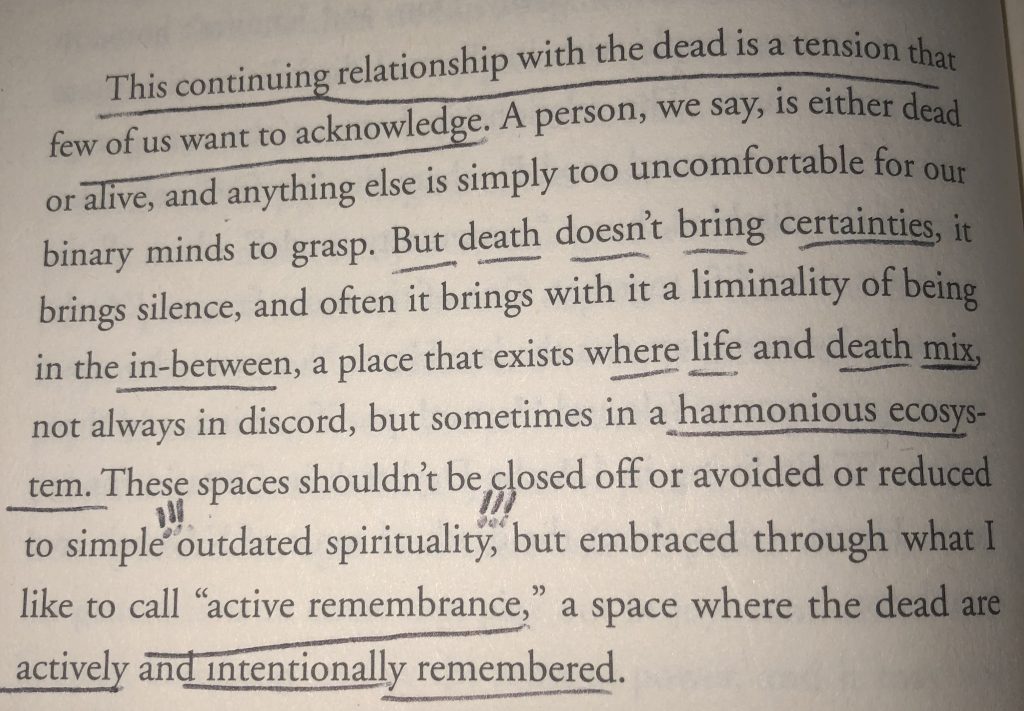
There’s a whole chapter dedicated to active remembering in my book, and the assumption is that we actively remember those that we love. But, there’s also an active remembering that’s based on hate. The family of Kathleen Dehmlow is practicing active remembering. And they’re doing it very well because it seems MANY people know about Kathleen and her less than virtuous life.
I guess this is how I feel about obituary shaming: I wish we could practice active remembering that’s based on love as well as the family of Kathleen did in hate.
*****
If you like my writing, consider buying my 2017 Nautilus Book Award Gold Winner, Confession of a Funeral Director (click the image to go to the Amazon page):
All Souls Day: Giving Our Dead a Place at the Table
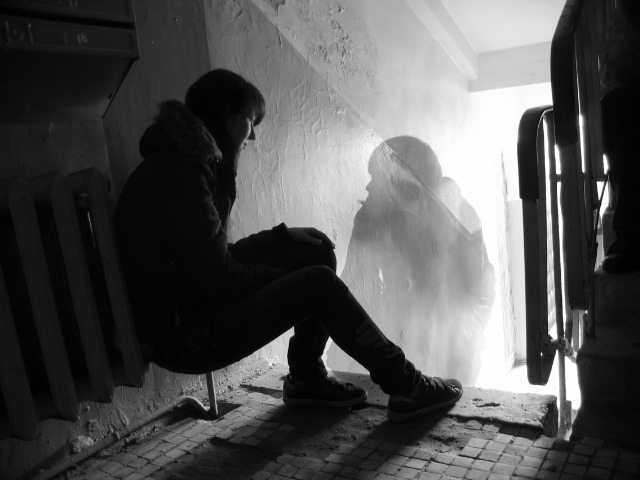
Author: jzool
Author URL: https://www.flickr.com/people/jzool/
Title: she and a ghost
Year: 2008
A couple years ago, my funeral home buried a saint named Jennifer. As far as I know, she didn’t perform any supernatural miracles, like turning water into wine, but she did a kind of miracle that suspends our natural evolutionary tendencies. Per the testimony of her family, she performed her miracles with everyone she met, far surpassing the two-miracle quota required for official canonization.
Jennifer had Down syndrome. Most of the people I know with Down syndrome have a beautifying effect on their family and friends. It’s not necessarily because DS produces more happiness (studies show that depression plagues those with DS), nor is it because caring for someone with DS makes everything easier (although there are reports that divorce rates drop in families that have a DS member), but it seems that position prominence, egotism, and power hunger have little persuasion on these treasured saints of humanity. It’s as if that extra chromosome 21 provides a trade-off, where there’s less mental capability but more character capacity, providing immunity to that desire for survival at other’s expense. And Jennifer had this spades.
Jennifer lived with her parents, Kathy and Don, who were both in their late seventies and retired. On a humid Pennsylvania morning, Don went to wake Jennifer for breakfast and found her lying peacefully in her bed with no apparent signs of a struggle. She was dead.
Jennifer was taken to our county’s morgue where the coroner did her work in trying to determine the cause of death. When a deceased person is a coroner’s case, if the cause of death isn’t entirely apparent, the final cause of death – and the final death certificate – is not issued for a couple weeks while the toxicology tests await their results.
Kathy and Don entrusted my grandfather, my dad and I with Jennifer’s funeral arrangements. Funerals are like a living mosaic. You give away pieces of yourself throughout your life and sometimes many of these pieces come back to form a living piece of artwork … at a funeral. I’ve worked a number of funerals throughout my 15 years at my family’s funeral home, but Jennifer’s display was a masterpiece. This group of people that gathered for Jennifer’s funeral – her living mosaic — created a wonderful aura of kindness, understanding, and togetherness.
In our culture, these living mosaics take place just once in the form of a funeral. And that’s it. But even funerals are becoming less and less engrained in our cultural ethos – for a reason I can’t entirely put my finger on – we’re slowly moving the dead out of the spaces of the living. Maybe we think it’s morbid to give the dead space? Maybe we’d just rather forget … or we think remembering is too painful? Maybe we think this ostracization is a part of closure?
When we do remember, it’s often something that we stumble upon, passively, and hardly ever corporately. We smell our dad’s cologne in a crowded street and we’re suddenly brought to tears. We find a picture of our grandmother stuffed in our desk and our mind is flooded with memories. As beautiful and cathartic as these passive experiences can be, I’d like to think that it would be even healthier if we invited our dead into our spaces through a more active form of remembering like Kathy and Don did with Jennifer when they gave her a communal space even after her death.
A couple weeks after Jennifer’s funeral, the final death certificates arrived at our funeral home with “sudden cardiac arrest due to sleep apnea” inscribed as Jennifer’s cause of death, a cause that was expected now finalized. I called Kathy and let her know I’d be willing to bring the death certificates to her house, she agreed and an hour later she and her husband welcomed me into their home to show me something they made for Jennifer. I write about what I saw in my book:
“Come into the kitchen, she said. I walked through the archway into the kitchen and saw something I’d never seen before. Jennifer’s place at the kitchen table was covered with a shrine – a collection of items that had been meaningful to Jennifer. I had associated a shrine with the worship of a demigod or saint, but Jennifer’s family took the broader meaning. They dedicated this spot entirely to the memory of their daughter.
“We thought it’d be a good idea,” Kathy said. I was slightly taken aback by the whole thing. If you had asked me the first word that came to mind when I saw it, I would have said ‘weird’, maybe even ‘pathological’. But after Kathy started to explain the different parts of the shrine and their meaning, I understood my reaction had been hasty.
Looking back, I see that my initial problem with Jennifer’s shrine was that it didn’t portray that strong American sense of tackling and overcoming grief. Americans love to problem-solve, and we hate sitting in the tension, and many of us, even some therapists, see grief as a problem that needs solving, a wound that needs healing, and a chapter that needs closure. But Jennifer’s shrine stood in the tension of avoidance and closure and acknowledged that grief is present, it’s present in this home, and that’s okay.
Somewhat unknowingly, Kathy and Don were practicing All Souls Day, the day some believers actively give their dead space among the living. Days like All Saints and All Souls are more deeply felt in other cultures that know how to exist in the tension of the presence of our dead, but for many of us, it’s a nearly forgotten day that comes after the costumes and candy of Halloween.
The term “saint” has a lot of baggage attached to its meaning, and maybe that’s where we lose our way. We’ve packed it with religious meaning and holiness and miracles. But it’s a term that we need to reclaim if we’re to venerate the lives of our elders, and find their power and love in the present. If we remove the baggage and strip it down to its core, we’ll find we all have had saints in our lives, saints who have molded us for good. Maybe it’s your mother who tirelessly encouraged you to pursue your dreams. Maybe it’s your grandfather who stepped in when you Dad left home and family. Maybe it’s the family matriarch who guided your family with her prayers and grace.
These dead – our saints – need to have a space at our table, sometimes literally like Kathy and Don’s shrine, sometimes figuratively. By connecting to our dead, by actively remembering our saints, by swinging back into the past, we can be more settled in our present and propelled into our future, connecting the circle that is so often broken by when the dead are excluded. This is about making us whole by accepting that things gone are still present. It’s about self-realization as an individual and as a family by letting our history inform our inner person. It’s about giving voice to a people that although dead are still speaking. It’s about actively remembering by making sure that our saints, like Jennifer to Kathy and Don, still hold space in our lives.
During this season of Allhallowtide, I’ll leave these thoughts with this question: What are some ways you and your family can practice active remembering and bring your saints into your present?
My book is now available for purchase (click the image to see the Amazon page):
